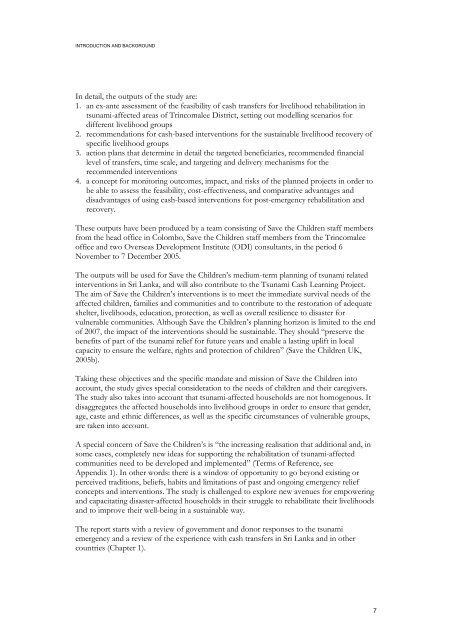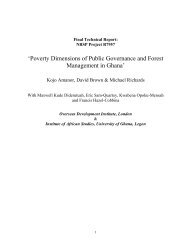Feasibility study on a capital-based income generation scheme for ...
Feasibility study on a capital-based income generation scheme for ...
Feasibility study on a capital-based income generation scheme for ...
You also want an ePaper? Increase the reach of your titles
YUMPU automatically turns print PDFs into web optimized ePapers that Google loves.
INTRODUCTION AND BACKGROUND<br />
In detail, the outputs of the <str<strong>on</strong>g>study</str<strong>on</strong>g> are:<br />
1. an ex-ante assessment of the feasibility of cash transfers <strong>for</strong> livelihood rehabilitati<strong>on</strong> in<br />
tsunami-affected areas of Trincomalee District, setting out modelling scenarios <strong>for</strong><br />
different livelihood groups<br />
2. recommendati<strong>on</strong>s <strong>for</strong> cash-<strong>based</strong> interventi<strong>on</strong>s <strong>for</strong> the sustainable livelihood recovery of<br />
specific livelihood groups<br />
3. acti<strong>on</strong> plans that determine in detail the targeted beneficiaries, recommended financial<br />
level of transfers, time scale, and targeting and delivery mechanisms <strong>for</strong> the<br />
recommended interventi<strong>on</strong>s<br />
4. a c<strong>on</strong>cept <strong>for</strong> m<strong>on</strong>itoring outcomes, impact, and risks of the planned projects in order to<br />
be able to assess the feasibility, cost-effectiveness, and comparative advantages and<br />
disadvantages of using cash-<strong>based</strong> interventi<strong>on</strong>s <strong>for</strong> post-emergency rehabilitati<strong>on</strong> and<br />
recovery.<br />
These outputs have been produced by a team c<strong>on</strong>sisting of Save the Children staff members<br />
from the head office in Colombo, Save the Children staff members from the Trincomalee<br />
office and two Overseas Development Institute (ODI) c<strong>on</strong>sultants, in the period 6<br />
November to 7 December 2005.<br />
The outputs will be used <strong>for</strong> Save the Children’s medium-term planning of tsunami related<br />
interventi<strong>on</strong>s in Sri Lanka, and will also c<strong>on</strong>tribute to the Tsunami Cash Learning Project.<br />
The aim of Save the Children’s interventi<strong>on</strong>s is to meet the immediate survival needs of the<br />
affected children, families and communities and to c<strong>on</strong>tribute to the restorati<strong>on</strong> of adequate<br />
shelter, livelihoods, educati<strong>on</strong>, protecti<strong>on</strong>, as well as overall resilience to disaster <strong>for</strong><br />
vulnerable communities. Although Save the Children’s planning horiz<strong>on</strong> is limited to the end<br />
of 2007, the impact of the interventi<strong>on</strong>s should be sustainable. They should “preserve the<br />
benefits of part of the tsunami relief <strong>for</strong> future years and enable a lasting uplift in local<br />
capacity to ensure the welfare, rights and protecti<strong>on</strong> of children” (Save the Children UK,<br />
2005b).<br />
Taking these objectives and the specific mandate and missi<strong>on</strong> of Save the Children into<br />
account, the <str<strong>on</strong>g>study</str<strong>on</strong>g> gives special c<strong>on</strong>siderati<strong>on</strong> to the needs of children and their caregivers.<br />
The <str<strong>on</strong>g>study</str<strong>on</strong>g> also takes into account that tsunami-affected households are not homogenous. It<br />
disaggregates the affected households into livelihood groups in order to ensure that gender,<br />
age, caste and ethnic differences, as well as the specific circumstances of vulnerable groups,<br />
are taken into account.<br />
A special c<strong>on</strong>cern of Save the Children’s is “the increasing realisati<strong>on</strong> that additi<strong>on</strong>al and, in<br />
some cases, completely new ideas <strong>for</strong> supporting the rehabilitati<strong>on</strong> of tsunami-affected<br />
communities need to be developed and implemented” (Terms of Reference, see<br />
Appendix 1). In other words: there is a window of opportunity to go bey<strong>on</strong>d existing or<br />
perceived traditi<strong>on</strong>s, beliefs, habits and limitati<strong>on</strong>s of past and <strong>on</strong>going emergency relief<br />
c<strong>on</strong>cepts and interventi<strong>on</strong>s. The <str<strong>on</strong>g>study</str<strong>on</strong>g> is challenged to explore new avenues <strong>for</strong> empowering<br />
and capacitating disaster-affected households in their struggle to rehabilitate their livelihoods<br />
and to improve their well-being in a sustainable way.<br />
The report starts with a review of government and d<strong>on</strong>or resp<strong>on</strong>ses to the tsunami<br />
emergency and a review of the experience with cash transfers in Sri Lanka and in other<br />
countries (Chapter 1).<br />
7
















